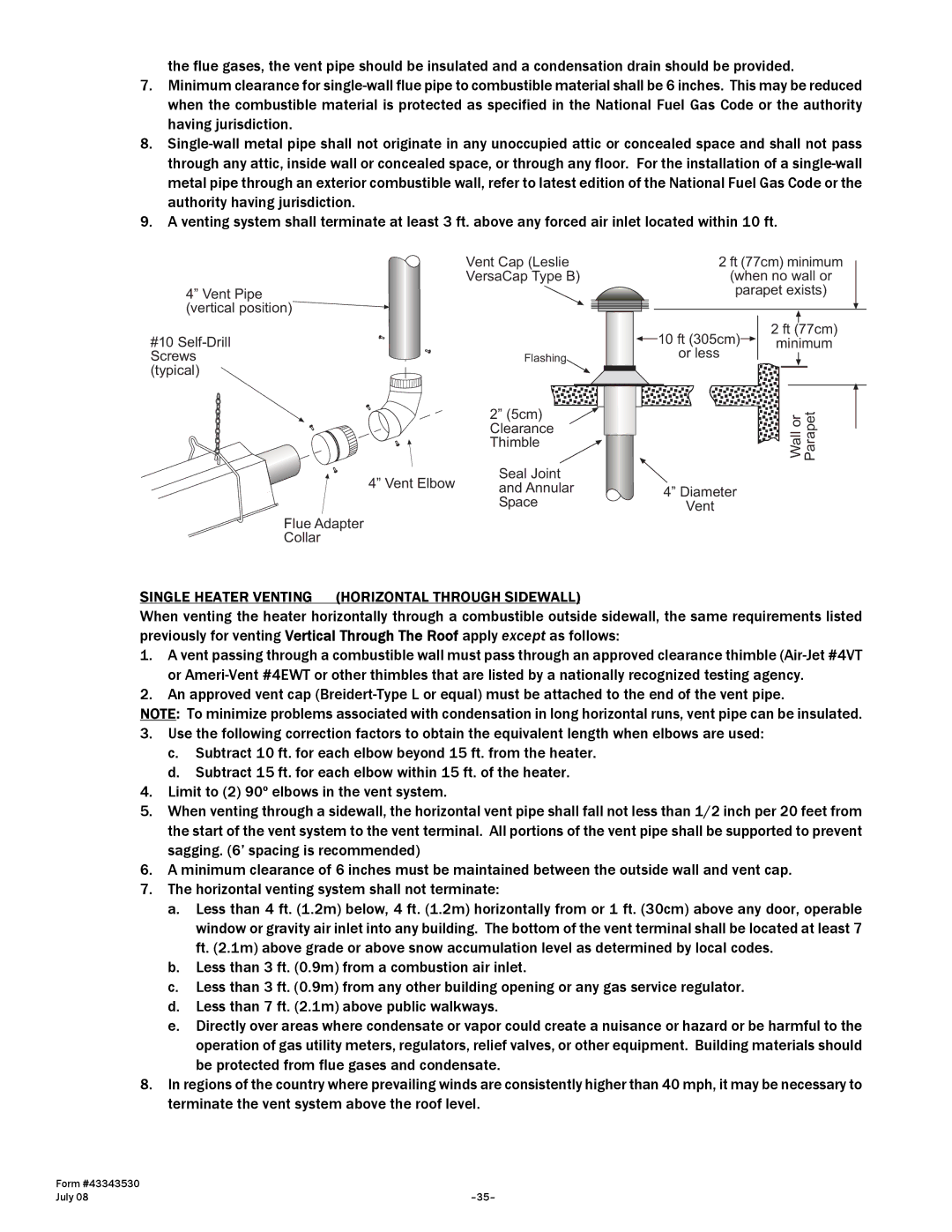
the flue gases, the vent pipe should be insulated and a condensation drain should be provided.
7.Minimum clearance for
8.
9.A venting system shall terminate at least 3 ft. above any forced air inlet located within 10 ft.
Vent Cap (Leslie VersaCap Type B)
4” Vent Pipe (vertical position)![]()
#10
Screws![]() Flashing (typical)
Flashing (typical)
2” (5cm) ![]() Clearance Thimble
Clearance Thimble
Seal Joint
4” Vent Elbow and Annular
Space
Flue Adapter
Collar
|
|
|
|
|
|
| ||||||||||
|
|
| 2 ft (77cm) minimum |
|
| |||||||||||
|
| |||||||||||||||
|
|
|
| (when no wall or |
|
|
| |||||||||
|
|
|
| parapet exists) |
|
|
| |||||||||
|
|
|
|
|
|
|
|
|
|
|
|
|
|
|
|
|
|
|
|
|
|
|
|
|
|
|
|
|
|
|
|
|
|
|
|
|
|
|
|
|
|
|
|
|
|
|
|
|
|
|
|
|
|
|
|
|
|
|
|
|
|
| |||||
|
|
|
|
|
|
| 2 ft | (77cm) | ||||||||
|
| 10 ft (305cm) |
|
|
| minimum |
|
|
|
| ||||||
|
|
|
|
|
|
|
| |||||||||
|
| or less |
|
|
|
|
|
| ||||||||
|
|
|
|
|
|
|
|
|
|
|
|
|
|
| ||
|
|
|
|
|
|
|
|
|
|
|
|
|
|
|
| |
|
|
|
|
|
|
|
|
|
|
|
|
|
|
|
|
|
|
|
|
|
|
|
|
|
|
|
|
|
|
|
| ||
|
|
|
|
|
|
|
|
|
| |||||||
|
| 4” Diameter |
|
| Wall or Parapet |
|
| |||||||||
|
|
|
|
| ||||||||||||
|
|
|
|
|
|
|
|
|
|
|
| |||||
|
| Vent |
|
|
|
|
|
|
|
|
|
|
|
|
| |
SINGLE HEATER VENTING (HORIZONTAL THROUGH SIDEWALL)
When venting the heater horizontally through a combustible outside sidewall, the same requirements listed previously for venting Vertical Through The Roof apply except as follows:
1.A vent passing through a combustible wall must pass through an approved clearance thimble
2.An approved vent cap
NOTE: To minimize problems associated with condensation in long horizontal runs, vent pipe can be insulated.
3.Use the following correction factors to obtain the equivalent length when elbows are used:
c.Subtract 10 ft. for each elbow beyond 15 ft. from the heater.
d.Subtract 15 ft. for each elbow within 15 ft. of the heater.
4.Limit to (2) 90º elbows in the vent system.
5.When venting through a sidewall, the horizontal vent pipe shall fall not less than 1/2 inch per 20 feet from the start of the vent system to the vent terminal. All portions of the vent pipe shall be supported to prevent sagging. (6’ spacing is recommended)
6.A minimum clearance of 6 inches must be maintained between the outside wall and vent cap.
7.The horizontal venting system shall not terminate:
a.Less than 4 ft. (1.2m) below, 4 ft. (1.2m) horizontally from or 1 ft. (30cm) above any door, operable window or gravity air inlet into any building. The bottom of the vent terminal shall be located at least 7 ft. (2.1m) above grade or above snow accumulation level as determined by local codes.
b.Less than 3 ft. (0.9m) from a combustion air inlet.
c.Less than 3 ft. (0.9m) from any other building opening or any gas service regulator.
d.Less than 7 ft. (2.1m) above public walkways.
e.Directly over areas where condensate or vapor could create a nuisance or hazard or be harmful to the operation of gas utility meters, regulators, relief valves, or other equipment. Building materials should be protected from flue gases and condensate.
8.In regions of the country where prevailing winds are consistently higher than 40 mph, it may be necessary to terminate the vent system above the roof level.
Form #43343530 |
|
July 08 |
